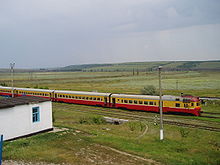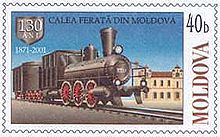- Calea Ferată din Moldova
-
Calea Ferată din Moldova 
Type State enterprise (Întreprindere de stat) Industry Rail transport Headquarters Chişinău, Moldova Key people Ilie Turcanu, Director General Products Rail transport, cargo transport, services Owner(s) The Moldovan state Website www.railway.md/en/
Timetable (in Romanian)CFM (Calea Ferată din Moldova, which means ″Moldovan Railway″ in Romanian) is the only railway operator in the Republic of Moldova, that is responsible for passenger and cargo transportation, as well as the railway infrastructure maintenance, within the country. It is the successor of MZhD, a subdivision of the USSR railway. The total length of the network managed by CFM (as of 2009) is 1232 km, of which 1218 km is 1,520 mm (4 ft 11 5⁄6 in) (broad gauge), and 14 km is 1,435 mm (4 ft 8 1⁄2 in) (standard gauge). The entire network is single track and is not electrified. It borders the Romanian railway network, 1,520 mm (4 ft 11 5⁄6 in)/1,435 mm (4 ft 8 1⁄2 in) break-of-gauge, on the west, and the Ukrainian one on the east.
Contents
History
In 1844, Governor-General of Novorossiya and Bessarabia Count Mikhail Vorontsov has developed a project of a railway, connecting Odessa and Parcani village by the Dniester. Odessa- Kiev railway company proposed to connect Odessa and Kiev with a branch to Parcani via Tiraspol. According to the decree of Nikolay I, the construction was sponsored by the government funds.
In 1871 a bridge over the Dniester was constructed. On August 28, 1871, the railway linking Tiraspol with Chişinău was officially opened. This date is recognized as the date of establishment of Moldovan Railways. The line, connecting Bessarabia to the Black Sea and the railway network of Ukraine and Russia became the basis for the future development.
On May 18 [O.S. May 6] 1872 a Russian diplomat agent, Ivan Alekseevich Zinov'ev and the Romanian Minister of Foreign Affairs Gheorghe Costaforu signed a rail junction covention, which was ratified on January 21 [O.S. January 9] 1873.[1] On June 1, 1875, the line Chişinău-Corneşti-Ungheni was opened (the Chişinău-Corneşti railway was built between 1871 and 1873) and connection to Romania was established. The Eiffel Bridge was opened on April 21 [O.S. April 9] 1877, just three days before the outbreak of the Russo-Turkish War (1877–1878).
In the first months of the war the Tighina-Basarabeasca-Reni-Giurgiuleşti line was hastily built; it opened in November 1877. In 1893-1894 the Lipcani-Ocniţa-Otaci, Ocniţa-Bălţi and Bălţi-Floreşti-Râbniţa-Cobasna lines started operation. During World War I the Bălţi-Ungheni section was built.
In the early 1920s, as Moldova had united with Romania, the tracks were converted to standard gauge. In the interwar years the Basarabeasca-Cantemir and Revaca-Căinari lines appeared.
After World War II Moldova became part of the Soviet Union and the rail network reverted to broad gauge. During the Soviet era the Cantemir-Cahul line was built (1971).
In 2005 the Revaca-Căinari railway was rebuilt (it was destroyed in 1944) and in 2007-2008 a Cahul-Giurgiuleşti line was constructed.
Rolling stock
Most of the rolling stock used by CFM was manufactured in the USSR and other countries of the Soviet block. The most widespread type of the traction unit is Soviet-built triple section 3TE10M (sometimes only 1 or 2 sections are used). Their use in Moldova was motivated by steep gradients on some portions of the rail network (especially, in the regions with hilly terrains), where additional power was needed to pull heavy freight trains. Other popular types of locomotives are M62 ("Mashka") and 2TE10L. Sometimes, Czech-built shunters ChME3 are used as traction units for local passenger operations. The only type of DMU operated by CFM is D1, manufactured by Hungarian Ganz-MAVAG.
Political involvement
CFM personnel largely consists of Russian speakers, Russian is the language used in the process of operation. Notably, CFM chief executive Miron Gagauz, who held the post of the Minister of Transportation, was one of few members of the Government who did not speak the official language of the country. Historically, CFM has good relations with the Communist Party of Moldova. In 2009, its employees signed a letter where they condemned the opposition protests that followed the 2009 parliamentary elections. They described the events as "an attempt to bring chaos into the country and to destroy everything positive that was built by the current government", claimed that "the elections were carried out in conformity with the international norms and national law on elections" and "the victory of the communists is a logical result of their eight-year stay in power", expressed "full support to the elected power", and called on "punishing the responsible".
Rail links to adjacent countries
Between Moldova and Romania there is a break-of-gauge (Romania employing standard gauge). The most important crossing (including gauge changing equipment) is Ungheni-Iaşi, another two are Cantemir-Falciu and Giurgiuleşti-Galaţi. International passenger trains run to Bucharest, Kiev, Minsk, Saint Petersburg and Moscow.
- Same gauge:
- break-of-gauge:
 Romania 1,520 mm (4 ft 11 5⁄6 in)/1,435 mm (4 ft 8 1⁄2 in)
Romania 1,520 mm (4 ft 11 5⁄6 in)/1,435 mm (4 ft 8 1⁄2 in)
Gallery
See also
References
- ^ Frederick Kellog, The road to Romanian independence, 1995, p.84
External links
- "Railway of Moldova". http://railway.md/en/. Retrieved April 9, 2009.
National railway companies of Europe  HSH •
HSH •  HYU1 •
HYU1 •  ÖBB •
ÖBB •  ADY1 •
ADY1 •  BŽD/BČ •
BŽD/BČ •  SNCB/NMBS •
SNCB/NMBS •  ŽFBH2 and ŽRS3 •
ŽFBH2 and ŽRS3 •  BDŽ •
BDŽ •  HŽ •
HŽ •  ČD •
ČD •  DSB •
DSB •
 EVR •
EVR •  VR •
VR •  SNCF •
SNCF •  SR1 •
SR1 •  DB •
DB •  TrainOSE •
TrainOSE •  MÁV •
MÁV •  IÉ •
IÉ •  FS •
FS •  KTŽ1 •
KTŽ1 •  HK/KŽ4 •
HK/KŽ4 •  LDZ •
LDZ •  LG •
LG •
 CFL •
CFL •  MŽ •
MŽ •  CFM •
CFM •  ŽCG •
ŽCG •  NS •
NS •  NSB •
NSB •  PKP •
PKP •  CP •
CP •  CFR •
CFR •  RŽD •
RŽD •  ŽS •
ŽS •  ŽSR •
ŽSR •  SŽ •
SŽ •
 RENFE •
RENFE •  SJAB •
SJAB •  SBB/CFF/FFS •
SBB/CFF/FFS •  TCDD1 •
TCDD1 •  UZ •
UZ •  BR5 / NR6 / NIR71Country partly in Asia • 2For the Federation BH • 3For Srpska • 4State with limited recognition • 51948-2000
BR5 / NR6 / NIR71Country partly in Asia • 2For the Federation BH • 3For Srpska • 4State with limited recognition • 51948-2000
6Created in 1999, owned by ATOC • 7For Northern IrelandRail transport in Europe Sovereign
states- Albania
- Andorra
- Armenia
- Austria
- Azerbaijan
- Belarus
- Belgium
- Bosnia and Herzegovina
- Bulgaria
- Croatia
- Cyprus
- Czech Republic
- Denmark
- Estonia
- Finland
- France
- Georgia
- Germany
- Greece
- Hungary
- Iceland
- Ireland
- Italy
- Kazakhstan
- Latvia
- Liechtenstein
- Lithuania
- Luxembourg
- Macedonia
- Malta
- Moldova
- Monaco
- Montenegro
- Netherlands
- Norway
- Poland
- Portugal
- Romania
- Russia
- San Marino
- Serbia
- Slovakia
- Slovenia
- Spain
- Sweden
- Switzerland
- Turkey
- Ukraine
- United Kingdom
- Vatican City
States with limited
recognition- Abkhazia
- Kosovo
- Nagorno-Karabakh
- Northern Cyprus
- South Ossetia
- Transnistria
Dependencies
and other territories- Åland
- Faroe Islands
- Gibraltar
- Guernsey
- Jan Mayen
- Jersey
- Isle of Man
- Svalbard
Other entities Categories:- Rail transport in Moldova
- Railway companies
Wikimedia Foundation. 2010.






